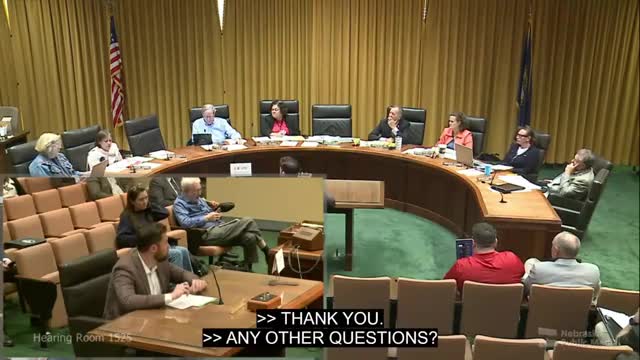Greater Omaha Chamber highlights Nebraska's energy needs for economic development growth
September 06, 2025 | Business and Labor , Standing, Committees, Legislative, Nebraska
This article was created by AI summarizing key points discussed. AI makes mistakes, so for full details and context, please refer to the video of the full meeting. Please report any errors so we can fix them. Report an error »

The Nebraska Legislature's Natural Resources Committee convened on September 5, 2025, to discuss critical issues surrounding renewable energy development in the state. The meeting highlighted significant challenges and opportunities for Nebraska's energy infrastructure, particularly in relation to economic development.
The session began with a discussion on the primary challenges facing renewable energy sources in Nebraska. A key point raised was the lengthy process of interconnection and transmission for wind and solar facilities. Stakeholders noted that once a suitable site is identified, the ability to connect to the grid can take years, often delaying project development. This issue is compounded by the geographical mismatch between where renewable energy is generated—typically in rural areas—and where it is needed, primarily in urban centers. This creates a dilemma for developers regarding whether to invest in energy generation or transmission infrastructure first.
Jennifer Krieger, representing the Greater Omaha Chamber, emphasized the importance of energy availability for economic growth. She pointed out that modern businesses are increasingly energy-intensive, and their location decisions are heavily influenced by the power generation capacity of potential sites. Krieger noted that Nebraska is well-positioned to meet these demands, with the Omaha Public Power District (OPPD) planning to double its generation capacity by the end of the decade. She advocated for a diverse energy strategy that includes various sources such as natural gas, wind, solar, and nuclear to ensure future growth.
The discussion also touched on the competitive landscape for energy development, with Krieger highlighting that neighboring states like South Dakota have lower taxes on wind and solar development. She warned that Nebraska must remain competitive in energy investments to avoid falling behind economically.
Senator Conrad raised concerns about the evolving priorities of businesses regarding energy sources. Krieger acknowledged that while some companies previously prioritized renewable energy, the current focus has shifted towards ensuring reliable power availability, regardless of the source.
The meeting concluded with Eric Stalker from AES, a company involved in renewable energy, expressing gratitude for the opportunity to discuss the state's energy landscape. He highlighted AES's role in operating Nebraska's largest solar facility, underscoring the potential for growth in the renewable sector.
Overall, the meeting underscored the interconnectedness of energy availability and economic development in Nebraska, with stakeholders advocating for a comprehensive approach to address the state's energy needs and ensure future competitiveness.
The session began with a discussion on the primary challenges facing renewable energy sources in Nebraska. A key point raised was the lengthy process of interconnection and transmission for wind and solar facilities. Stakeholders noted that once a suitable site is identified, the ability to connect to the grid can take years, often delaying project development. This issue is compounded by the geographical mismatch between where renewable energy is generated—typically in rural areas—and where it is needed, primarily in urban centers. This creates a dilemma for developers regarding whether to invest in energy generation or transmission infrastructure first.
Jennifer Krieger, representing the Greater Omaha Chamber, emphasized the importance of energy availability for economic growth. She pointed out that modern businesses are increasingly energy-intensive, and their location decisions are heavily influenced by the power generation capacity of potential sites. Krieger noted that Nebraska is well-positioned to meet these demands, with the Omaha Public Power District (OPPD) planning to double its generation capacity by the end of the decade. She advocated for a diverse energy strategy that includes various sources such as natural gas, wind, solar, and nuclear to ensure future growth.
The discussion also touched on the competitive landscape for energy development, with Krieger highlighting that neighboring states like South Dakota have lower taxes on wind and solar development. She warned that Nebraska must remain competitive in energy investments to avoid falling behind economically.
Senator Conrad raised concerns about the evolving priorities of businesses regarding energy sources. Krieger acknowledged that while some companies previously prioritized renewable energy, the current focus has shifted towards ensuring reliable power availability, regardless of the source.
The meeting concluded with Eric Stalker from AES, a company involved in renewable energy, expressing gratitude for the opportunity to discuss the state's energy landscape. He highlighted AES's role in operating Nebraska's largest solar facility, underscoring the potential for growth in the renewable sector.
Overall, the meeting underscored the interconnectedness of energy availability and economic development in Nebraska, with stakeholders advocating for a comprehensive approach to address the state's energy needs and ensure future competitiveness.
View full meeting
This article is based on a recent meeting—watch the full video and explore the complete transcript for deeper insights into the discussion.
View full meeting
